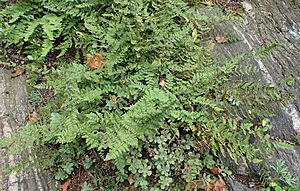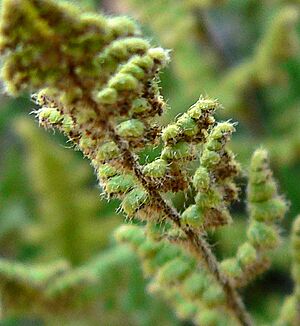Hairy lip fern facts for kids
Quick facts for kids Hairy lip fern |
|
|---|---|
 |
|
| Hairy lip fern growing among rocks | |
| Conservation status | |
| Scientific classification | |
| Genus: |
Myriopteris
|
| Species: |
lanosa
|
| Synonyms | |
|
|
The hairy lip fern, known scientifically as Myriopteris lanosa, is a medium-sized fern found in the eastern United States. It belongs to the Pteridaceae family. This fern gets its common name because its leaves and stems have some hairs but no scales. It was once thought to be part of the Cheilanthes group. However, in 2013, scientists decided it belonged to a different group called Myriopteris. The hairy lip fern usually grows in dry, shallow soil, often on rocks.
Contents
What Does the Hairy Lip Fern Look Like?
The hairy lip fern grows from a thick underground stem called a rhizome. This rhizome is usually about 4 to 8 millimeters (0.16 to 0.31 inches) wide. It has small, flat scales that are brown and stick close to its surface.
Fern Fronds and Stems
The fern's leaves, called fronds, grow in bunches. When they first appear, they are curled up like a fiddlehead. When they are fully grown, the fronds can be 7 to 50 centimeters (2.8 to 20 inches) long and 1.5 to 5 centimeters (0.59 to 2.0 inches) wide. Both fronds that produce spores and those that don't look similar.
The stalk of the leaf, called the stipe, is 3 to 18 centimeters (1.2 to 7.1 inches) long. It is dark brown or purplish-black and covered with many long, dark hairs.
Leaf Blades and Hairs
The main part of the leaf, called the blade, can be shaped like a spear or slightly wider at the top. The blade is usually divided into smaller sections near its base. Each blade has about 12 to 20 pairs of these smaller sections, called pinnae.
The central stem of the leaf blade, called the rachis, is dark and covered with soft hairs. The pinnae (leaflets) are not directly attached to the main stem. The dark color of the rachis extends into the edges of the pinnae. The pinnae at the bottom of the leaf are a bit smaller than those above them. The top surfaces of the pinnae have a few hairs.
The smallest parts of the leaf, called pinnules, are also spear-shaped or wider at their tips. They are not round like beads, which helps tell this fern apart from some other Myriopteris species. Each pinna has 7 to 14 pairs of pinnules. The largest pinnules are 3 to 5 millimeters (0.12 to 0.20 inches) long. They have long, segmented hairs on both their top and bottom surfaces.
How the Fern Reproduces
On fronds that produce spores, the sori (clusters of spore cases) are protected by a false indusia. This is formed by the edge of the leaf curling back over the underside. These false indusia look a bit like the rest of the leaf. They are 0.05 to 0.25 millimeters (0.0020 to 0.0098 inches) wide.
Underneath these coverings, the sori are not in long lines. Instead, they are broken up and found on the tips and sides of the pinnules. Each spore case (sporangium) holds 64 spores. The fern's cells have 60 chromosomes.
Where Does the Hairy Lip Fern Grow?
The hairy lip fern is found in the Appalachian Mountains, from Connecticut all the way southwest to Alabama. It also grows north through middle Tennessee into the Shawnee Hills and west through the Ozarks. You can find smaller groups of these ferns as far away as Wisconsin, the Oklahoma Panhandle, Louisiana, and west Florida.
This fern likes to grow in shallow soil on rocky slopes and ledges. It doesn't usually grow on steep cliff faces. It can be found at altitudes from 100 to 800 meters (330 to 2,600 feet). The type of rock doesn't seem to matter much, as it grows on limestone, granite, and sandstone. It can also be found in open woodlands and other open areas.
Conservation Status
Globally, the hairy lip fern is considered safe. However, in some states at the edge of its range, it is facing threats. It has disappeared from Delaware and is only known from historical records in New York.
NatureServe, an organization that tracks the health of species, says it is critically endangered in Connecticut, Louisiana, and Texas. It is considered endangered in Indiana, Kansas, Mississippi, and New Jersey. It is also vulnerable in Illinois.
Growing Hairy Lip Ferns
This fern is quite easy to grow. It needs medium to high light and soil that drains well and is acidic. The soil should be dry to slightly moist.
Images for kids





